
Plaça de Catalunya, Barcelona
Encyclopedia


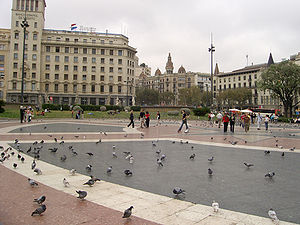
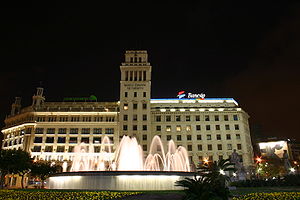
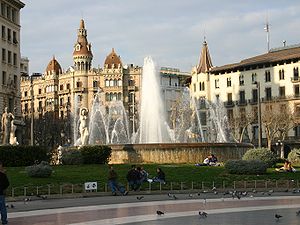
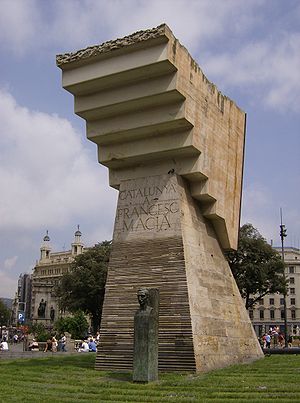
English language
English is a West Germanic language that arose in the Anglo-Saxon kingdoms of England and spread into what was to become south-east Scotland under the influence of the Anglian medieval kingdom of Northumbria...
"Catalonia Square") is a large square in central Barcelona
Barcelona
Barcelona is the second largest city in Spain after Madrid, and the capital of Catalonia, with a population of 1,621,537 within its administrative limits on a land area of...
that is generally considered to be both its city centre and the place where the old city (see Barri Gòtic
Barri Gòtic
The Gothic Quarter is the centre of the old city of Barcelona. It stretches from La Rambla to Via Laietana, and from the Mediterranean seafront to Ronda de Sant Pere....
and Raval, in Ciutat Vella
Ciutat Vella
Ciutat Vella is a district of Barcelona, numbered District 1. The name means "old city" in Catalan and refers to the oldest neighborhoods in the city of Barcelona, Spain. Ciutat Vella is nestled between the Mediterranean Sea and the neighborhood called l'Eixample...
) and the 19th century-built Eixample
Eixample
The Eixample is a district of Barcelona between the old city and what were once surrounding small towns , constructed in the 19th and early 20th centuries....
meet.
Some of the city's most important streets and avenues meet at Plaça Catalunya: Passeig de Gràcia, Rambla de Catalunya, La Rambla or Portal de l'Àngel
Portal de l'Àngel
Portal de l'Àngel is a pedestrian street in the Ciutat Vella district of Barcelona by Plaça Catalunya, and part of the large shopping area that spans from Avinguda Diagonal to Barri Gòtic...
, in addition to Ronda de Sant Pere, Carrer de Vergara or Carrer de Pelai. The plaza occupies an area of about 50,000 square metres. It is especially known for its fountains and statues, its proximity to some of Barcelona's most popular attractions, and for the flocks of pigeons that gather in the centre.
History
After the medieval city walls were demolished in the 19th century, ambitious designs for the city's public spaces were conceived under the guidance of notable urban plannersUrban planning
Urban planning incorporates areas such as economics, design, ecology, sociology, geography, law, political science, and statistics to guide and ensure the orderly development of settlements and communities....
. Plaça Catalunya was conceived as part of pla Rovira in 1859, but no official permission from the government was given until the 1888 Universal Exposition. It was urbanised for the first time in 1902 and was further modified in 1929, on the occasion of the 1929 Barcelona International Exposition
1929 Barcelona International Exposition
The 1929 Barcelona International Exposition took place from 20 May 1929 to 15 January 1930 in Barcelona, Catalonia, Spain...
, which also included the construction of a metro
Rapid transit
A rapid transit, underground, subway, elevated railway, metro or metropolitan railway system is an electric passenger railway in an urban area with a high capacity and frequency, and grade separation from other traffic. Rapid transit systems are typically located either in underground tunnels or on...
station. Architect Francisco Nebot designed the changes made in 1929.
In May 2011 Plaça Catalunya was the main location where anti-government protests
2011 Spanish protests
The 2011 Spanish protests, also referred to as the 15-M Movement and the Indignants movement, are a series of ongoing demonstrations in Spain whose origin can be traced to social networks and Real Democracy NOW among other civilian digital platforms and 200 other small associations...
and sit ins were held in Barcelona, mirroring the events in other Spanish cities.
Sculpture
Plaça Catalunya hosts quite a few interesting sculptures representative of NoucentismeNoucentisme
Noucentisme was a Catalan cultural movement of the early 20th century that originated largely as a reaction against Modernisme, both in art and ideology, and was, simultaneously, a perception of art almost opposite to that of avantgardists...
, Neo-Classicism and different avantgarde movements.
- Deessa, by Josep ClaràJosep ClaràJosep Clarà i Ayats was a Spanish sculptor.Clarà was born in Olot, Gerona, Spain in 1878. He attended the Olot School of Drawing with professor Josep Berga i Boix...
. - Pastor de Pau, by Pablo GargalloPablo GargalloPablo Emilio Gargallo was a Spanish sculptor and painter.Born in Maella, Aragon, he moved to Barcelona, Catalonia, with his family in 1888, where he would begin his training in the arts. Gargallo developed a style of sculpture based on the creation of three-dimensional objects from pieces of flat...
. - Francesc Macià monument. It reads: "Catalunya a Francesc Macià".
- Josep Llimona's sculptures.
Decorative arts
The mosaicMosaic
Mosaic is the art of creating images with an assemblage of small pieces of colored glass, stone, or other materials. It may be a technique of decorative art, an aspect of interior decoration, or of cultural and spiritual significance as in a cathedral...
s that decorate the walls of the underground part of Plaça Catalunya were designed by pupils of Escola Massana.
Theatre
A few theatres have been established in Plaça Catalunya since its construction, none of which are extant.- Teatre del Bon Retir (1876-1885)
- Circ Eqüestre Alegria (1879-1895)
- Eldorado Concert (1887-1929)
- Teatre Barcelona (1923-198-)
There still are, however, other theatres in the nearby area, located in other streets or squares.
Cafés and restaurants
Similarly, most of the cafés and restaurants where writers and artists would meet in the city haven't survived, with the notable exception of Café Zurich, where Fabiola of BelgiumQueen Fabiola of Belgium
Queen Fabiola of Belgium is the widow of King Baudouin of Belgium. She was Queen consort of the Belgians for 33 years...
's brother worked as a pianist. The following ones disappeared with the Spanish Civil War
Spanish Civil War
The Spanish Civil WarAlso known as The Crusade among Nationalists, the Fourth Carlist War among Carlists, and The Rebellion or Uprising among Republicans. was a major conflict fought in Spain from 17 July 1936 to 1 April 1939...
:
- Maison Dorée
- Café Colón
- La Lluna
- Cafè Suís
Shopping centres
- El Corte InglésEl Corte InglésEl Corte Inglés S.A. , headquartered in Madrid, is the biggest department store group in Europe and ranks fourth worldwide...
- El Triangle, containing a three-story fnacFnacFnac is an international entertainment retail chain offering cultural and electronic products, founded by André Essel and Max Théret in 1954. It is the largest retailer of its kind in France...
shop. - SferaSFeraSFera is a science fiction society from Zagreb, Croatia. It was founded in 1976, thus marking the beginnings of organised science fiction fandom in the region....
Hotels
- H10 Catalunya Plaza
- Hotel Monegal
- Olivia Plaza Hotel: 4 stars hotel. Olivia Plaza Phone +34933168700
- Hotel urquinaona Hotel Urquinaona
Financial institutions
- Banco Español de Crédito (Banesto).
- Banco Bilbao Vizcaya ArgentariaBanco Bilbao Vizcaya ArgentariaBanco Bilbao Vizcaya Argentaria, S.A. is a multinational Spanish banking group. It was formed in 1999 from the merger of Banco Bilbao Vizcaya and Argentaria, both of which in turn had previously amalgamated three important banks in Spain, namely Banco de Bilbao, Banco de Vizcaya, Banco Exterior de...
(BBVA). - Banco de EspañaBanco de EspañaThe Bank of Spain , is the national central bank of Spain. Established in Madrid in 1782 by Charles III, today the bank is a member of the European System of Central Banks.-History:...
- Caja MadridCaja MadridCaja Madrid, formally the Caja de Ahorros y Monte de Piedad de Madrid, headquartered in Madrid, is the oldest of the Spanish savings banks. It was founded on December 3, 1702 as Monte de Piedad de Madrid by Francisco Piquer, an Aragonese priest...
Transport

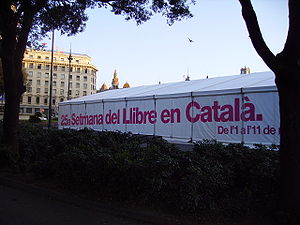
Metro
The original Barcelona metroBarcelona Metro
The Barcelona Metro , part of the public transportation system of Barcelona, Catalonia, is an extensive network of electrified railways that run underground in central Barcelona and above ground into the city's suburbs. Since July 31, 2010, Barcelona Metro system consists of 11 lines with 165...
line in Barcelona, known as Gran Metro, had Plaça Catalunya as one of its termini. It went to become the current green line, L3
Barcelona Metro line 3
— Line 3, currently known as Zona Universitària - Trinitat Nova, coloured green and often simply referred to as Línia verda , is a metro line in Barcelona operated by TMB, and therefore part of the fare-integrated ATM transport network of the urban region...
, operated by TMB
Transports Metropolitans de Barcelona
Transports Metropolitans de Barcelona is the main public transit operator in Barcelona, made up of two formerly separate companies, Ferrocarril Metropolità de Barcelona, SA. and Transports de Barcelona, SA....
. It's also served by two FGC
Ferrocarrils de la Generalitat de Catalunya
Ferrocarrils de la Generalitat de Catalunya , or FGC, is a railway company which operates several unconnected lines in Catalonia, Spain....
lines.
- Catalunya (L1Barcelona Metro line 1— Line 1, shortened to L1 and known as "Hospital de Bellvitge - Fondo", coloured red and often simply called Línia vermella , is the second oldest metro line in Barcelona, after L3. It is operated by Transports Metropolitans de Barcelona . It appeared as a means to join the rail stations the city...
, L3Barcelona Metro line 3— Line 3, currently known as Zona Universitària - Trinitat Nova, coloured green and often simply referred to as Línia verda , is a metro line in Barcelona operated by TMB, and therefore part of the fare-integrated ATM transport network of the urban region...
, L6Barcelona Metro line 6— Line 6, coloured navy blue, is the name of a metro-like commuter train service in Barcelona operated by FGC, and part of the ATM fare-integrated transport system. It links Plaça Catalunya, the city centre, with Sarrià-Sant Gervasi...
, L7Barcelona Metro line 7— Line 7, coloured brown , is a metro-like commuter train line in the Barcelona Metro network operated by FGC, and part of the ATM fare-integrated transport system. Also known as Línia de Balmes, as it climbs Carrer de Balmes uphill into Tibidabo, it shares three stations with FGC L6...
) - Passeig de Gràcia (L2Barcelona Metro line 2Line 2 is a metro line in Barcelona operated by TMB, coloured purple and sometimes simply called línia lila. It's part of the city's ATM fare-integrated transport network...
, L3Barcelona Metro line 3— Line 3, currently known as Zona Universitària - Trinitat Nova, coloured green and often simply referred to as Línia verda , is a metro line in Barcelona operated by TMB, and therefore part of the fare-integrated ATM transport network of the urban region...
, L4Barcelona Metro line 4— Line 4, currently known as Trinitat Nova – La Pau, usually called "línia groga" , is a line in the Barcelona Metro network operated by TMB, and part of the ATM fare-integrated transport network...
).
Day bus
- Bus 9 Pl. Catalunya - Pg. Zona Franca
- Bus 14 Vil·la Olímpica - Pg. Bonanova
- Bus 16 Urquinaona - Pg. Manuel Girona
- Bus 17 Barceloneta - Av. Jordà
- Bus 24 Av. Paral·lel - Carmel
- Bus 28 Pl. Catalunya - Carmel
- Bus 41 Pl. Francesc Macià - Diagonal Mar
- Bus 42 Pl. Catalunya - Santa Coloma
- Bus 55 Parc de Montjuïc - Plaça Catalana
- Bus 58 Pl. Catalunya - Av. Tibidabo
- Bus 59 Pg. Marítim - Plaça Reina Maria Cristina
- Bus 66 Pl. Catalunya - Sarrià
- Bus 67 Pl. Catalunya - Cornellà
- Bus 68 Pl. Catalunya - Cornellà
- Bus 141 Av. Mistral - Barri del Besòs
- Aerobus
Nitbus
Barcelona's night bus is known as Nitbus and most of its lines serve Plaça Catalunya:- N1 Zona Franca (Mercabarna) - Pl. Catalunya - Roquetes (Aiguablava)
- N2 Av. Carrilet - Pl. Catalunya - Badalona (Montigalà)
- N3 Collblanc - Montcada i Reixac
- N4 Via Favència - Pl. Catalunya - Gran Vista
- N5 Pl. Catalunya - Gran Vista
- N6 Barcelona (Roquetes) - Santa Coloma (Oliveres)
- N7 Pl. Pedralbes - Pl. Llevant (Fòrum)
- N8 Can Caralleu - Santa Coloma (Can Franquesa)
- N9 Pl. Portal de la Pau - Tiana (Edith Llaurador)
- N11 Barcelona (Pl. Catalunya) - H. Can Ruti
In popular culture
Plaça de Catalunya is a featured locale in the 2009 video game Wheelman, published by Midway GamesMidway Games
Midway Games, Inc. is an American company that was formerly a major video game publisher. Following a bankruptcy filing in 2009, it is no longer active and is in the process of liquidating all of its assets. Midway's titles included Mortal Kombat, Ms.Pac-Man, Spy Hunter, Tron, Rampage, the...
.
See also
- Avinguda de la LlumAvinguda de la LlumAvinguda de la Llum is a now closed underground mall in Barcelona, the first one of its kind to open in Europe, open between 1940 and 1990, on a 2000 square-metre site built in 1929 and boasting 68 commercial establishments, including a movie theater...
- Font de CanaletesFont de CanaletesFont de Canaletes ; is an ornate fountain, crowned by a lamp post, in Barcelona, Catalonia, in Rambla de Canaletes, the upper part of La Rambla, near Plaça de Catalunya...
- History of BarcelonaHistory of BarcelonaThe history of Barcelona stretches back well over 2000 years to its origins as an Iberian village, named Barkeno. Its easily defensible location on the coastal plain between the Collserola ridge and the Mediterranean sea, on the coastal route between central Europe and the rest of the Iberian...
- List of streets and squares in Eixample

